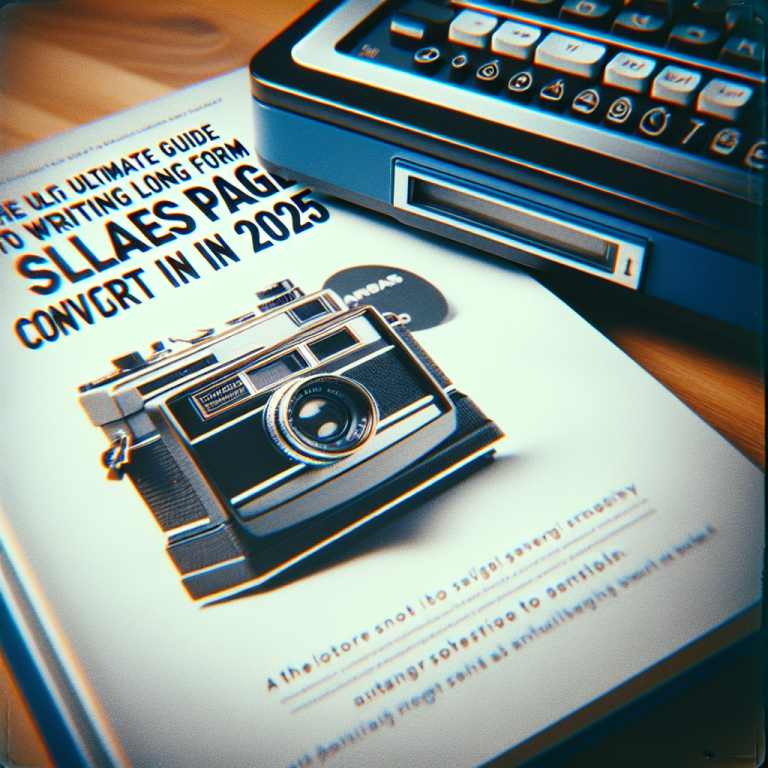10 Effective Copywriting and Keyword Optimization Strategies for 2025
Table of Contents
- 1. Embrace AI-Driven Keyword Research
- 2. Focus on User Intent and Content Relevance
- 3. Incorporate Long-Tail Keywords Strategically
- 4. Optimize for Voice Search and Conversational Queries
- 5. Prioritize Mobile-First Copywriting
- 6. Use Semantic SEO and Related Keywords
- 7. Enhance Readability and User Experience
- 8. Leverage Data and Analytics for Continuous Improvement
- 9. Incorporate Visual Content with SEO in Mind
- 10. Stay Updated with Algorithm Changes and Trends
1. Embrace AI-Driven Keyword Research
Understanding the Power of AI Tools
In 2025, leveraging artificial intelligence for keyword research has become essential for effective copywriting and keyword optimization. AI tools can analyze massive data sets to identify high-impact keywords that your target audience is actively searching for. Unlike traditional research methods, AI can uncover niche and emerging keywords that are often overlooked.
For example, platforms like ChatGPT or specialized SEO software such as MarketMuse now provide insights into semantic relevance and predicted search trends. This allows writers and marketers to craft content that aligns perfectly with evolving user interests, giving your content a competitive edge.
By integrating AI-powered keyword research into your workflow, you ensure your content remains relevant, targeted, and optimized for maximum visibility in 2025 search results.
Actionable Tips for AI Integration
- Use AI tools to generate keyword ideas based on search intent and related topics.
- Analyze competitorsâ top-ranking pages to identify gaps and opportunities.
- Regularly update your keyword strategy by monitoring real-time trends flagged by AI applications.
2. Focus on User Intent and Content Relevance
Understanding User Search Intent
In 2025, the key to effective copywriting and keyword optimization is prioritizing user intent. Search engines have become increasingly sophisticated in understanding the reason behind a queryâbe it informational, navigational, transactional, or commercial investigation. Your content must meet these needs to rank well and engage readers.
For instance, if the keyword phrase âcopywriting and keyword optimizationâ is used, ask yourself: Are users seeking how-to guides, tools, or industry trends? Tailor your content accordingly to match their queries with relevant answers, resulting in higher engagement and conversions.
By aligning your content with user intent, you not only optimize for keywords but also for providing real value, which boosts your authority and rankings over time.
Practical Steps to Enhance Content Relevance
- Conduct search intent analysis for your target keywords.
- Create content types that match different user goals: tutorials, case studies, or product reviews.
- Use structured data to help search engines understand your contentâs relevance better.
3. Incorporate Long-Tail Keywords Strategically
The Value of Long-Tail Keywords in 2025
Long-tail keywords remain vital for effective copywriting and keyword optimization in 2025. These specific phrases attract highly targeted traffic, often with less competition, making your content more discoverable to the right audience.
For example, instead of targeting broad terms like âcopywriting,â focusing on âbest copywriting tips for SaaS startups in 2025â can attract a niche audience actively searching for detailed information. This precision improves your chances of higher rankings and conversions.
Research shows that long-tail keywords generate about 70% of all web searches, emphasizing their importance in modern SEO strategies.
How to Find and Use Long-Tail Keywords
- Utilize keyword research tools to identify long-tail variations related to your core keywords.
- Incorporate these phrases naturally into your titles, headers, and body content.
- Create dedicated content that addresses specific long-tail topics to boost relevancy and authority.
4. Optimize for Voice Search and Conversational Queries
The Rise of Voice Search
In 2025, voice search accounts for over 50% of all searches, transforming how people find information. Optimizing copywriting and keyword optimization strategies for voice involves focusing on natural language and long-tail conversational queries.
Instead of keyword stuffing, craft content that answers questions clearly and directly, mimicking natural speech patterns. For instance, optimize for questions like âWhat are the best copywriting and keyword optimization tips for 2025?â rather than just âcopywriting tips.â
This approach positions your content for featured snippets, voice assistants, and mobile searches, increasing your visibility across multiple platforms.
Practical Tips for Voice Search Optimization
- Incorporate question-based keywords naturally into your content.
- Use succinct summaries and bullet points for quick answers.
- Ensure your website is mobile-friendly for optimal voice search performance.
5. Prioritize Mobile-First Copywriting
The Importance of Mobile Optimization in 2025
By 2025, over 70% of web traffic is expected to come from mobile devices. Therefore, effective copywriting and keyword optimization hinge on creating mobile-first content that loads quickly, reads easily, and engages users on smaller screens.
Your copy should be concise, with clear headings and scannable format. Use bullet points and short paragraphs to enhance readability, making sure that your calls-to-action are prominent and compelling.
Test your websiteâs mobile usability regularly using tools like Googleâs Mobile-Friendly Test to ensure optimal performance and prevent ranking penalties.
Actionable Tips for Mobile-First Content
- Optimize font sizes and spacing for easier reading.
- Prioritize loading speed by compressing images and minimizing scripts.
- Ensure that your primary keywords are incorporated naturally within mobile-optimized content.
6. Use Semantic SEO and Related Keywords
Understanding Semantic SEO
Semantic SEO involves optimizing content with related keywords and contextually relevant terms rather than focusing solely on exact keywords like âcopywriting and keyword optimization.â It helps search engines understand the broader topic, increasing your chances of ranking for multiple queries.
For example, include related phrases like âcontent marketing strategies,â âSEO best practices,â or âdigital copywriting trendsâ within your content. These variations support your main keywords and enhance your contentâs authority on the subject.
Semantic optimization is particularly crucial in 2025, as search engines continue evolving to understand context and intent over exact keyword matches.
Practical Implementation
- Use LSI (Latent Semantic Indexing) keywords naturally throughout your copy.
- Update older content by adding related terms and relevant subtopics.
- Leverage tools like Google NLP API to identify semantically related keywords for your content.
7. Enhance Readability and User Experience
Creating Engaging Copy
The best copywriting and keyword optimization are ineffective if users find your content hard to read or navigate. Prioritize clarity, simplicity, and engagement. Use active voice, straightforward language, and compelling storytelling to draw readers in.
Break content into digestible chunks with headings, bullet points, and visuals. This keeps users engaged and reduces bounce ratesâan important ranking factor in 2025.
Additionally, always test your websiteâs layout across devices to ensure a seamless user experience that encourages longer visits and conversions.
Pro Tips for Better UX
- Use clear, descriptive headings with keywords included naturally.
- Incorporate visual elements like images with optimized alt text and infographics.
- Maintain a consistent, clean design that aligns with your brand voice and personality.
8. Leverage Data and Analytics for Continuous Improvement
Measuring Your Content Performance
In 2025, data-driven decision-making is critical for refining your copywriting and keyword optimization strategies. Use analytics platforms like Google Analytics and Search Console to monitor how your content is performing, focusing on metrics such as organic traffic, bounce rate, and conversion rate.
Identify which keywords are driving engagement and adjust your content accordingly. This ongoing process ensures your efforts are aligned with user behavior and search engine algorithms.
Furthermore, A/B testing different headlines, copy variations, and calls-to-action can reveal what resonates best with your audience.
Action Steps to Maximize ROI
- Set specific KPIs related to your marketing goals.
- Regularly audit your content to identify underperformers.
- Use insights to inform future content strategies and keyword targeting.
9. Incorporate Visual Content with SEO in Mind
The Role of Visuals in Content Engagement
Visual content like images, videos, and infographics significantly boost user engagement and convey complex ideas more effectively. In 2025, SEO best practices extend to optimizing visuals with keyword-rich alt text, descriptive filenames, and structured data.
For example, pairing relevant images with your copywriting and keyword optimization efforts can increase your chances of appearing in image search results, expanding your reach.
Additionally, videos can improve dwell time, signaling search engines that your content is valuable, thereby boosting rankings.
Best Practices for Visual SEO
- Add descriptive, keyword-rich alt text to all images.
- Use captions and transcripts for videos to help search engines understand content.
- Compress images and videos to ensure fast loading times.
10. Stay Updated with Algorithm Changes and Trends
The Importance of Continuous Learning
SEO is an ever-evolving field, especially with frequent algorithm updates from Google. In 2025, staying ahead requires continuous learning about the latest trends in copywriting and keyword optimization.
Follow authoritative SEO blogs, participate in webinars, and test new strategies to adapt quickly. This proactive approach ensures your content remains optimized for the latest criteria, maintaining or improving rankings.
Being adaptive also involves understanding new ranking factors, like AI content evaluation and user experience signals, which are increasingly influencing search results.
Actionable Tips for Staying Updated
- Subscribe to industry newsletters and forums.
- Regularly audit your website and content for compliance with new guidelines.
- Experiment with emerging SEO strategies and measure their impact.
Conclusion
Mastering effective copywriting and keyword optimization in 2025 is more critical than ever. By following these ten strategies, you can ensure your content not only ranks highly in search engines but also provides genuine value to your audience. Remember, the key to success lies in understanding user intent, leveraging innovative technologies, and consistently refining your approach.
Prioritizing the exact keyword phrase ‘copywriting and keyword optimization’ throughout your content will strengthen your SEO efforts and help you stand out in a crowded digital landscape. Stay adaptable, data-informed, and user-focused to thrive in 2025 and beyond.
Frequently Asked Questions
1. Why is copywriting and keyword optimization important in 2025?
Effective copywriting and keyword optimization are vital because they improve your content’s visibility, relevance, and user engagement, which are key ranking factors in the evolving search engine algorithms of 2025.
2. How can I incorporate semantic SEO into my content?
Use related keywords, natural language, and topical themes that support your main keywords. Tools like Google NLP can help identify semantically related terms to enhance your content’s depth and relevance.
3. What are some current trends in copywriting for 2025?
Trends include voice search optimization, mobile-first content, AI-powered tools, and a focus on user intent. Tailoring your copy to these trends helps maintain competitive rankings.
4. How often should I update my SEO strategies?
Regular updates are essentialâaim to review and adjust your SEO and copywriting tactics at least quarterly to stay aligned with algorithm changes and market trends.
5. How does keyword optimization influence user experience?
Proper keyword optimization helps users find relevant content quickly, making your site more engaging and accessible. It also improves readability when natural language and user intent are prioritized.









